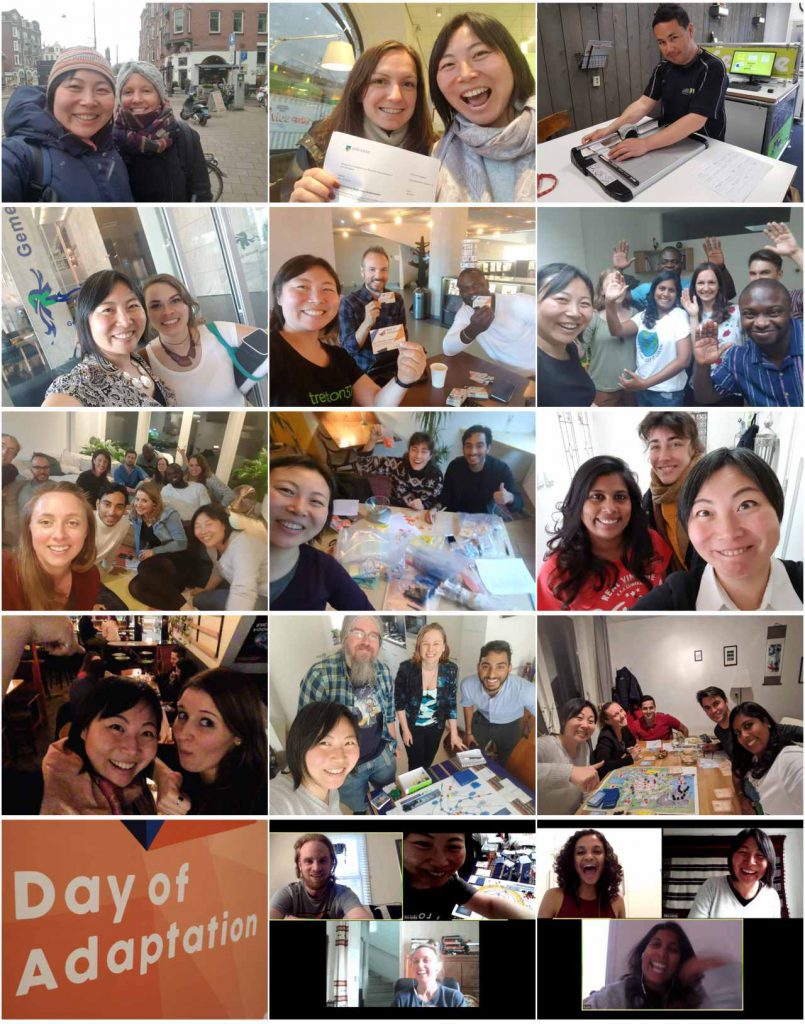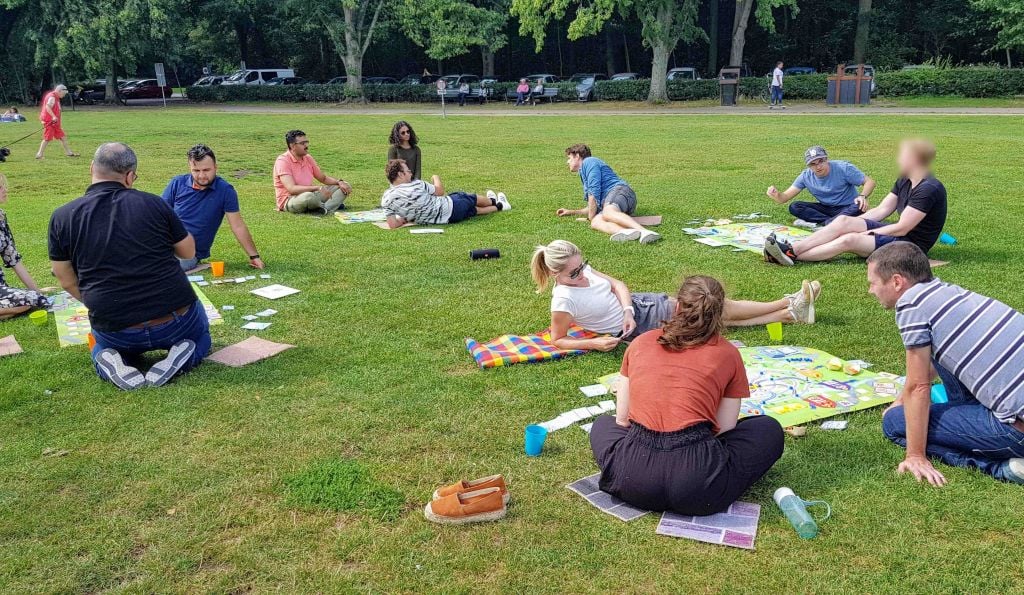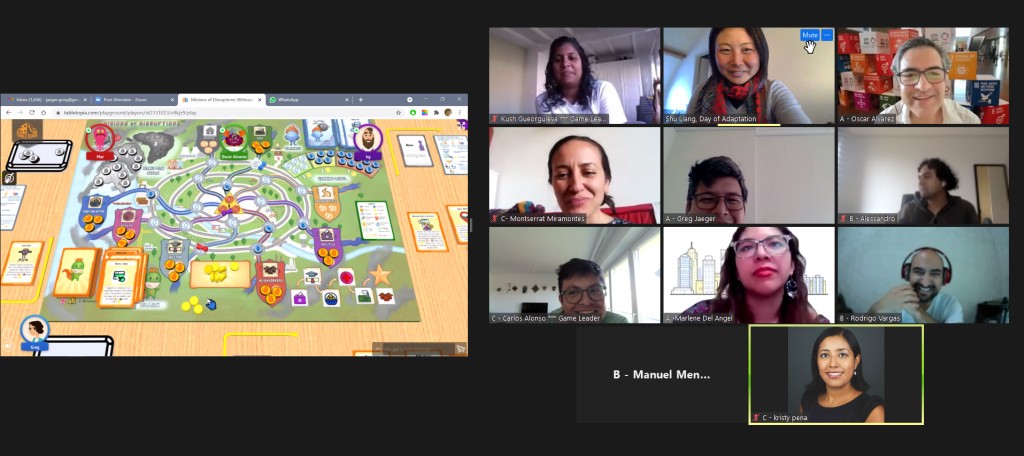Please help us improve PreventionWeb by taking this brief survey. Your input will allow us to better serve the needs of the DRR community.
Change the Game of Climate Change – the story of a collaborative climate board game as a climate communication innovation

Let’s play a quick game. When you hear the words “climate change”, what words come to mind?
Now, which of the words you thought of made you feel motivated and engaged?
Climate change is so scary that often people do not feel comfortable thinking about it, let alone taking action with their communities and organisations. Over the past two years I have been working on developing a Game Day experience that is designed to change the dynamics of how we communicate climate change. This article shares our journey of bringing playful, engaging, creative and collaborative elements to climate action.
Challenge within challenge
I distinctly remember the reaction from my acquaintance Chris when I mentioned that the speech I was going to deliver is about climate change. The curiosity disappeared immediately from her eyes, “Oh, I don’t want to listen to a speech about climate change!” Chris continued after taking a step back from me as if I was climate change itself. ”I get so depressed every time I read about it in the newspaper or hear about it in the videos. No way.”
Unfortunately Chris’ reaction is more common than many of us would like to believe. Over the course of several months I had similar conversations with people from all walks of life: taxi drivers, IT professionals, farmers, the list goes on. Generally the conversations gravitate to the same result – the topic is too negative or too abstract to grasp. Climate change is an unprecedented challenge in many ways. How can we collectively rise up to the challenge if people don’t even like to discuss it?
Globally, climate change narratives have been technical, and are predominantly characterized by distance, doom, dissonance and denial. In addition, information is rarely provided in ways that can be easily understood and acted upon. It is apparent that the climate change challenge before us is not just scientific or technical; it’s psychological.
Motivation and action go hand-in-hand. They lead to participatory processes and sustainable results. How can we motivate people to discuss the topic even if it is far from pleasant? That is the challenge I took upon myself to solve at the end of 2018.
Idea inception
The desire to take on the challenge led me to found Day of Adaptation (DAYAD), a non-profit organization based in the Netherlands. Our mission is to empower people from communities and organisations to understand, accept and commit to climate action.
To be honest, my desire was almost extinguished by questions such as, “What are you going to do that is different from everyone else who has been working on this for decades?” This skepticism inspired me to think more openly: How does the doom-and-gloom style communication make people feel? What communication style would be more likely to motivate people? What setting do people find most motivating?
Our approach emerged alongside our mission, and helped shape our theory of change: fun, interactive and relevant group activities promote engagement. Yes, all of this was backed up by research, but at the end of the day, it is also about intuition: people like fun and interactions, and we are motivated by each others’ presence. If you want evidence, look no further than how we interact with each other at sports and on social media.
How to design fun, interactive and engaging group activities in communicating climate change? I am not complaining, but with my Chinese upbringing and serious personality, being fun is not my forte, let alone designing fun. But where there is a will, there is a way. Within three months we designed and developed our first initiative “Dialogue Day”, where participants play superheroes and share with each other their super visions about climate change. We had some initial successes, but I was not content: it can be more fun. It needs to be more fun to compensate for the intrinsic complexity and heaviness of the topic.
Around this time my attention was drawn to board games as my husband was building a collection of our own. I dived into the world of climate change board games, but quickly it became clear to me that the market reflects the conventional style of communicating climate change. For example, CO2 is on international negotiations, Rescue Polar Bear portrays challenges as distant, and Keep Cool contains too much data.
So I put my own storyteller hat on, and three characters emerged with their unique behaviours and personalities: Carbions are the greenhouse gasses that escalate extreme climatic events; Climmies represents the increasing climatic risks that causes disruptions; Zillians are the resilience superheros that can eliminate Carbions and fend off Climmies. Together, Carbions, Climmies and Zillians model the climate change impacts and actions that people face in their communities and organisations – something that the participants can feel and relate to. And Minions of Disruptions was born.
Target Groups and Goals
I have always considered myself a nerd with little creativity, let alone a board game designer. It was critical to set out the game design with a strong framework. One key aspect in shaping the framework is identifying our target groups and goals.
From the beginning, we set our eyes on two types of target groups: organizations and communities. We did this for several reasons. First of all, they are units of resilience where people care about their immediate work and life environment, and are more likely to initiate and support climate actions. Secondly, the group dynamic is already established with familiarity and camaraderie between each other. Last but not least, team building and professional development culture in organizations is common, which is something that we can leverage. Organizations are more likely to have funding to support fun and engaging activities if we take on this win-win approach.
With the target groups in mind, we set out to list the ingredients that the game needs to have: awareness-raising, simulation, experiential learning, connections with other development subjects such as sustainability, circular economy, gender equality, etc. Because we also want to facilitate an experience for a large group of participants, the board game has many mechanisms of collaboration and cooperation.
Game Development
We followed a typical game development process: design, testing, production, promotion and evaluation. In reality, such linear depiction hardly reflects the actual challenging journey we went through. I did not study board game design and development. When things went wrong unexpectedly and spectacularly – and trust me, they did – we just had to start all over again.
A paragraph or two would be far from sufficient in capturing the game development processes. A few article headlines will do for now:
- An American, a Chinese and a Russian join their design powers
- How to party, game-testing style
- The Never-ending loop of feedback and redesign
It is nothing short of a miracle. Thanks to thousands of hours of volunteer contribution, at the end of 2019, we organized our very first Game Day and it was an immediate success!

Reception to-date
The Minions of Disruptions is only a centerpiece of a holistic climate experience that we call a Game Day. During a Game Day, a group of six to thirty or even more participants form teams to play the game where they collaborate to beat the clock and disruptions happening on the game board. This immersive gameplay is followed by a discussion which extends the narrated game experience into participants’ work and personal lives, reflecting their own experiences with individual and collective forms of climate action.
We have taken some big strides during COVID times: first, we created a MEGA game board in late 2019. The size of the board allows players to social distance. In early 2020 we went online and joined an online festival on climate adaptation organized by the Municipality of Groningen. As Jessica Appelmann, a German master’s student and one of our game leaders reflected: “The game really gets you to engage with the (climate) issue. It gets you to think about how it affects your own community and what initiatives can be taken.”

Through word-of-mouth, the game participation has been growing organically and steadily, played by 200+ participants in 15 sessions. Every time we host a Game Day, it is always inspiring to hear reactions from our clients, regardless of their locations: the Netherlands, the Philippines, Mexico and Chile. For example, Juan Pablo Toledo Hormazabal, a Chilean climate activist, ambitiously declares: “This game will help people in Chile to become aware of the emergency and at the same time give some innovative ideas of how to deal with the problems that the changing climate creates.”
Our approach has gained popularity as more and more clients, including companies, NGOs, universities, and the governments, organize Game Day sessions. Even better, our clients are willing to pay for the activities, yes, pay for resilience building activities so they can be sustainable in the long run. Don’t we wish all communities and organizations would be willing to join capacity building and disaster preparedness activities? Jem Bendell, a British professor of sustainability leadership and founder of Deep Adaptation Forum commented, “In a light-hearted way, it (N.B. Minions of Destructions) helps start the conversation about the range of difficult issues any organisation or community needs to work on right now.”
As of March 2021 we have started our very first scaling-up effort by partnering up with other development organizations such as Stichting Simavi, Kewasnet, ProPortion and Deltares. Together we aim to rewrite the narrative on climate and inequality through fun and play, and we are starting off by working with women, girls and youth in Kenya to identify more climate heroes to lead their communities in climate action.

Looking ahead
Looking back, my quest to change the game of climate change is both challenging and fruitful. As DAYAD continues to grow and evolve, I am confident that we will continue to do what we are best at: innovate the discussions surrounding climate change and therefore change the game of climate change. Looking ahead I have three questions in my head that I hope you can help with.
- Which communities and organizations in which parts of the world can we work with to find more local collaborations?
- How can we harness the motivation sparked by the game experience to promote tangible climate action?
- What can others take away from our past experiences? Can you apply our approach in your own work?
Perhaps one of the best ways to start answering these questions is to invite you to join us. We are ready to have a chat and set up a game for you and your colleagues.
To change the game of climate action, we need to connect to the hearts of communities and organisations, motivate our colleagues and neighbours to learn and become informed, and give them the encouragement to collaborate with each other.
So back to Minions of Disruptions. How would you bring Game Day into your climate action today?
Explore further
Please note: Content is displayed as last posted by a PreventionWeb community member or editor. The views expressed therein are not necessarily those of UNDRR, PreventionWeb, or its sponsors. See our terms of use
Is this page useful?
Yes No Report an issue on this pageThank you. If you have 2 minutes, we would benefit from additional feedback (link opens in a new window).